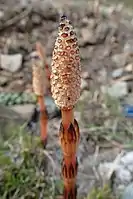Persistence (botany)
Persistence is the retention of plant organs, such as flowers, seeds, or leaves, after their normal function has been completed, in contrast with the shedding of deciduous organs after their purpose has been fulfilled.[1] Absence or presence of persistent plant organs can be a helpful clue in plant identification, and may be one of many types of anatomical details noted in the species descriptions or dichotomous keys of plant identification guides.[2] Many species of woody plants with persistent fruit provide an important food source for birds and other wildlife in winter.[3]

Species with persistent parts
There are numerous herbaceous and woody plant species that produce persistent parts, such as strobili (cones) or fruit. Note that the trait of persistence exhibited by a given species within a genus may not be exhibited by all species within the genus. For example, the Equisetum genus includes some species that have persistent strobili and others that have deciduous strobili.[4]
Persistent strobili
The following are examples of species with persistent strobili (cones):
- Equisetum arvense (common horsetail)[5]
- Larix occidentalis (western larch)[6]
- Picea mariana (black spruce)[7]
- Pinus banksiana (Jack pine)[7]
Persistent fruit
The following are examples of species with persistent fruit:
- Aronia arbutifolia (red chokeberry)[8]
- Berberis thunbergii (Japanese barberry)[9]
- Cornus florida (flowering dogwood)[10]
- Cotoneaster apiculatus (cranberry cotoneaster)[8]
- Crataegus phaenopyrum (Washington hawthorn)[8]
- Malus sargentii (Sargent crabapple)[11]
Image gallery
 Larix decidua has persistent seed cones.
Larix decidua has persistent seed cones. Equisetum arvense has persistent strobili.
Equisetum arvense has persistent strobili. This Cornus florida cultivar has persistent fruit into winter.
This Cornus florida cultivar has persistent fruit into winter. Seed cones of Pinus banksiana persist on branches long after seeds are released.
Seed cones of Pinus banksiana persist on branches long after seeds are released. Berberis thunbergii has persistent fruit.
Berberis thunbergii has persistent fruit._in_Geb%C3%BCschpflanzung%252C_Fr%C3%BCchte_am_Zweig%252C_Herbst%252C_01.jpg.webp) Malus sargentii has persistent fruit.
Malus sargentii has persistent fruit..jpg.webp)
.jpg.webp) Fruit of this Aronia arbutifolia cultivar persist through the winter and into early spring when new buds are emerging.
Fruit of this Aronia arbutifolia cultivar persist through the winter and into early spring when new buds are emerging.
See also
References
- Hitchcock, C. Leo; Cronquist, Arthur (2018). Flora of the Pacific Northwest (2nd ed.). Seattle: University of Washington Press. p. xxxviii, xliii. ISBN 978-0-29574-288-5.
- Saupe, Stephen. "Plant Identification (featuring Taxonomic Keys)". College of St. Benedict/St. John's University. Retrieved 2022-05-01.
- Jauron, Richard. "It's for the Birds!". Iowa State University Extension & Outreach. Retrieved 2022-05-01.
- Pojar, Jim; MacKinnon, Andy (1994). Plants of the Pacific Northwest Coast (2nd ed.). Lone Pine. pp. 428–431. ISBN 978-1-55105-530-5.
- Pojar, Jim; MacKinnon, Andy (1994). Plants of the Pacific Northwest Coast (2nd ed.). Lone Pine. p. 430. ISBN 978-1-55105-530-5.
- Hitchcock, C. Leo; Cronquist, Arthur (2018). Flora of the Pacific Northwest (2nd ed.). Seattle: University of Washington Press. p. 68. ISBN 978-0-29574-288-5.
- Morse, Susan. "High-Hanging Fruit: Boom and Bust Seed Crops of Conifers". Northern Woodlands. Retrieved 2022-05-01.
- Jauron, Richard. "Trees and Shrubs with Colorful Fruit in Fall and Winter". Iowa State University Extension and Outreach. Retrieved 2022-05-01.
- "Berberis thunbergii". USDA and USFS Fire Effects Information System (FEIS). Retrieved 2022-05-01.
- "Cornus florida". Missouri Botanical Garden. Retrieved 2022-05-01.
- Gilman, Edward; Watson, Dennis. "MALUS SARGENTII: SARGENT CRABAPPLE". University of Florida IFAS Extension. Retrieved 2022-05-01.